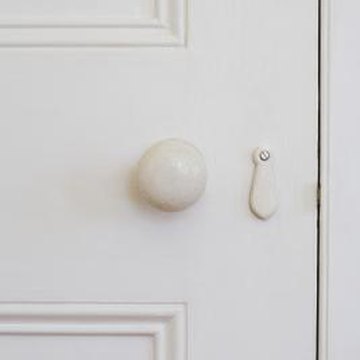
Mulitple colors of paint, sanded, give a plain door an antique look.
For
those who enjoy the look and craftsmanship found in homes from days
gone by, even the doors of old homes carry a warmth and quality often
not present in standard modern doors. Some modern doors are designed to
have the same style as antique doors, but simply look too new.
Faux-painting techniques and a little distressing of the wood or finish
makes that new door look like an antique. As an added element of fun,
apply coats of paint in varying colors, allowing layers to show through
as you sand away some of the paint, adding history to your work of art.
1
Open the door to a position in which both sides can be reached. Place old newspapers beneath the door. Cover windows, if any, handles and other hardware with painter's tape and newspaper to protect them.2
Sand the door gently with a medium- to fine-grit sanding block to create a grippable surface for the paint. Sand both sides of the door, as well as the edges, if you intend to paint those areas. Otherwise, only sand the side to be painted. Wipe the dust away with a tack cloth.3
Stir the all-in-one primer/paint with a stir stick, pouring the liquid into a paint tray. Apply the primer with a wide paintbrush, covering one or all both sides of the door and edges, as desired. Allow the primer/paint to dry completely.4
Rub a candle over the edges, corners and as much of the door as possible to create a thin wax layer on the door. Brush away excess wax with your hand.5
Stir the second color of paint and pour it into a paint tray. Coat the primed surfaces of the door with the top paint color, using a paintbrush. Allow the paint to dry thoroughly. Apply a second coat of paint as desired, allowing it to dry as well.6
Sand the corners, edges and other areas of the door prone to the most handling, such as the areas around the lock or doorknob, using a fine or medium-grit sanding block. Sand enough so the first paint color shows through in some areas, even down to the wood if you like in a few places. Wipe the door down with a tack cloth.7
Mix half water, half dark brown latex paint in a small disposable container, stirring it with a stir stick. Apply the paint to the door in quick, bold strokes of the paint brush. Rub most of the watery paint away with a clean rag. This enhances the look of age on the door.Things You Will Need
- Old newspaper
- Painter's tape
- Medium to fine-grit sanding block
- Tack cloth
- Latex all-in-one primer and paint
- Stir stick
- Paint trays
- Wide paintbrushes
- Candle
- Dark brown latex or acrylic paint (optional)
- Water
- Small container
Tip
- Quality paintbrushes shed less hair than inexpensive brushes.
- Antiquing a door can take on any look you'd like -- if you prefer the wood to show rather than be completely covered in paint, rubbing over it with a watered down, dark or white latex paint -- depending if you prefer a dark look or shabby chic look -- also adds the look of age.
- When the door has trim pieces or architectural elements, painting them in an alternate color, sanding away a good bit of the second color once the paint dries, adds to the aged look of the door.
- To create even more wear and tear to the look of the door before painting, file or sand away some of the wood on corners or protrusions, as if the door has been chipped years ago.
- An inexpensive wax candle suffices for the waxing process; the wax simply makes it easier to sand off the top coat of paint.
Warning
- Too much paint on the edge of the door may cause the door not to close properly.

No comments:
Post a Comment